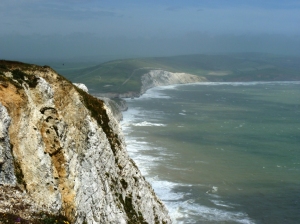On Wednesday and Thursday this week an expedition took place in search of Large Tortoiseshell larvae on NT land around Newtown on the Isle of Wight. It is unlikely that anyone had actually looked for the gregarious larval webs of this butterfly anywhere in the UK since at least the early 1950s. No one has been that mad, you might think, but as butterflies habitually push limits so butterflying must follow suit, and there has been an impressive scatter of sightings of the butterfly on the Island in recent years – enough to fire up the more determined of butterfly enthusiasts. This is my 50th year of butterflying, and I am not doing mundane things during it.
The annual butterfly & moth report of the Hampshire & IOW Branch of Butterfly Conservation indicates that the butterfly has been seen on the Island annually since 2005, when a singleton was recorded on Midsummer Day. The following spring one was seen in West Wight. Then something rather extraordinary happened in 2007: a few were seen in early spring, then a small influx seemingly occurred on 20th June, with perhaps another, small immigration occurring in early July. Early in 2008 six individuals were seen in widely scattered places, mainly along the SE coast. In 2009, no less than 19 were reported, including five on one early spring day in a privately-owned wood near Wootton. A few were also seen in that wood in 2010, and two early spring adults were recorded elsewhere followed by two more in high summer. In early 2011 several were seen in the Wootton wood, including three on 7th March, and two singletons were seen elsewhere, followed by a couple of fresh specimens in high summer. In 2012 none was seen near Wootton but at least four were seen in Walters Copse, part of the NT’s wildlife-rich countryside estate at Newtown. Two or three males were again seen at Walters Copse this spring, and on 23rd April I saw a female nearby in Newtown Meadows and another a mile away at Elm Hill. Hence yesterday’s expedition.
Though earnest, yesterday’s expedition was clearly doomed from its inception. For a start it was forced to take place at the beginning of the annual IOW Music Festival, an event which always attracts foul and abusive weather. Sure enough, a gale blew. Then Neil Hulme, the luckiest butterflyer in Christendom, pulled out – ostensibly so that he could go up north for the Mountain Ringlet. Without its talisman the expedition was reduced to two: Oates, who will undoubtedly get Sectioned at some point, and Patrick Barkham, who as an author and journalist was smelling out a rich tale.
No sign of the Large Tortoiseshell was found, but Patrick and I gave it our very best. On Wednesday, we scanned aspen, crab apple, sallow and what little elm there was along the rides and glades of Town and Walters Copses. On Thursday, we searched all but the exposed western extremity of the extensive hedge system in Newtown Meadows, and also cast our eyes over various orchard trees and a lot of roadside elm, even up at Elm Hill, south of Shalfleet. In the hedges we concentrated on the abundant English elm scrub, plus crab apple, broader-leaved sallow, mature sloe, bullace and orchard fruit trees. We also looked on aspen in the woods, though the tall aspen stand in the meadows was moving so much that searching was impossible. Sallow in exposed places was equally impossible, and we didn’t look on hawthorn.
We can almost certainly conclude that the butterfly is not breeding in Town & Walters Copses. I am confident we would have found larvae had any been present there. Likewise, I very much doubt it is breeding in the elm hedges in and around the meadows, or on the more sheltered sallows there. The problem is that our area of search was a relatively small, though rich, part of a large area of landscape full of copses and hedges possessing much English elm in the 3-10m height range.
I am not in the least downhearted, or even disappointed. It was always a long shot. I am, though, a trifle disappointed not to have turned up Purple Emperor larvae, though only a few of the sallow trees looked properly suitable.
The Large Tortoiseshell is now unlikely to win my annual Butterfly of the Year award. That may go to the Chalkhill Blue, given the unusual abundance and lush growth of its foodplant, Horseshoe Vetch. As examples, the south-facing slope of Afton & Compton Downs was more than ever awash with uncommonly luxuriant growth of this plant, whilst the top of Tennyson Down was almost as yellow as an oil seed rape field. Several Chalkhill Blue colonies exploded last year, following lush foodplant growth. Perhaps others will do likewise in 2013?
And of course, we also visited the Compton Bay coastline, the heartland of the Glanville Fritillary. The annual early spring count of Glanville Fritillary larval webs by IOWNHS produced a horribly low tally this year. Apparently only 13 webs were found, and then mainly around Compton Chine. However, on Tuesday, Patrick and I saw about 40 fresh Glanvilles there, only 4-5 of which were female. The butterfly should be at peak season at Compton next week, remarkably late by modern standards.
Here’s what the weather was like –
